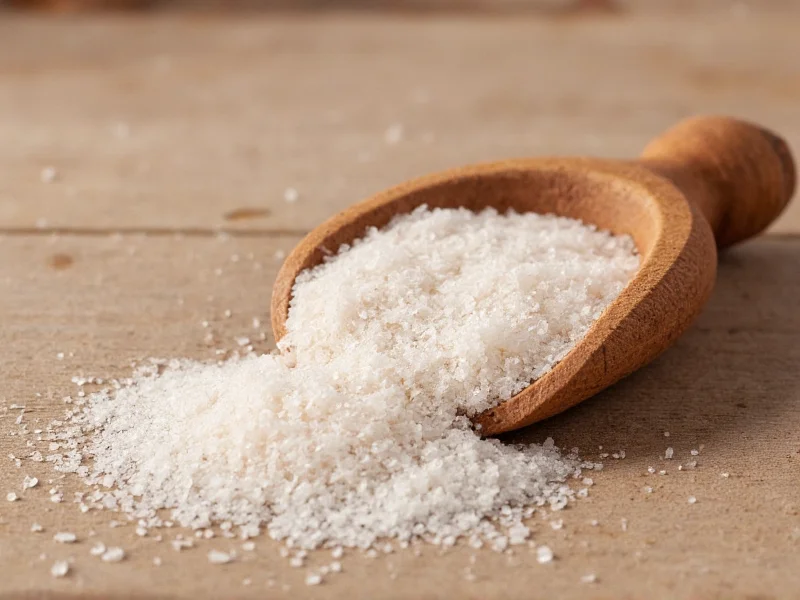Understanding what is seasoning salt requires examining its composition and culinary purpose. This kitchen staple typically contains salt as its primary ingredient (usually 60-80%), combined with garlic powder, onion powder, paprika, black pepper, and sometimes additional flavor boosters like citric acid or monosodium glutamate (MSG). The specific blend varies by region and manufacturer, creating distinct flavor profiles suitable for different cuisines.
Core Components of Seasoning Salt
While formulations differ, most seasoning salts share these fundamental elements:
| Component | Typical Percentage | Function |
|---|---|---|
| Salt (sodium chloride) | 60-80% | Primary seasoning and flavor enhancer |
| Garlic powder | 5-15% | Provides savory, aromatic notes |
| Onion powder | 5-12% | Adds sweetness and depth |
| Paprika | 2-8% | Contributes color and mild heat |
| Black pepper | 1-5% | Provides subtle heat and complexity |
Regional Variations and Popular Blends
When exploring what is seasoning salt made of, you'll discover significant regional differences that reflect local culinary traditions:
- Old Bay Seasoning (Mid-Atlantic US): Features celery salt, paprika, and red pepper, traditionally used for seafood
- Lawry's Seasoned Salt (Nationwide US): Contains garlic, onion, paprika, and MSG for versatile meat seasoning
- Adobo Seasoning (Latin America): Typically includes cumin, oregano, and花椒 (Sichuan pepper)
- Chinese Five-Spice (Asia): Though not strictly a "seasoning salt," often combined with salt for similar purposes
Practical Culinary Applications
Knowing how to use seasoning salt in cooking properly can transform your dishes. Unlike regular salt which primarily seasons, seasoning salt contributes multiple flavor dimensions:
Chefs recommend applying seasoning salt during cooking rather than just at the table. For meats, rub it into the surface before cooking to allow flavors to penetrate. In soups and stews, add it early in the cooking process to let the spices meld with other ingredients. When following recipes that call for both salt and individual spices, you can often substitute seasoning salt while reducing additional salt by about 25%.
Homemade vs. Commercial Seasoning Salt
Many home cooks wonder whether to buy seasoning salt or make your own. Creating your own blend offers several advantages:
- Control over sodium content (reducing salt while maintaining flavor)
- Avoidance of preservatives and anti-caking agents
- Customization for personal taste preferences or dietary needs
- Fresher flavor profile compared to store-bought versions
A basic homemade seasoning salt recipe combines 4 parts salt with 1 part each of garlic powder, onion powder, and paprika, plus ½ part black pepper. For those exploring what is the best seasoning salt for chicken, adding dried thyme and a touch of lemon zest creates an excellent poultry blend.
Substitution Strategies
When you're out of seasoning salt, understanding seasoning salt vs garlic salt and other alternatives becomes crucial. While garlic salt contains primarily garlic powder and salt, seasoning salt offers a more complex profile.
Effective substitutions include:
- Mixing equal parts table salt with your favorite spice blend
- Creating a temporary blend using salt plus garlic powder, onion powder, and paprika
- Using herb salts (like celery salt) with additional spices
Remember that is seasoning salt the same as seasoned salt? Yes, these terms are used interchangeably in culinary contexts, though some regional variations might have subtle differences in formulation.
Nutritional Considerations
While seasoning salt enhances flavor, it's important to consider sodium content. A typical ¼ teaspoon serving contains approximately 400-500mg of sodium. Those monitoring sodium intake can create lower-sodium versions by replacing some salt with potassium chloride or using salt substitutes, though this may alter the flavor profile slightly.
Storage and Shelf Life
Proper storage maintains seasoning salt's potency. Keep it in an airtight container away from heat and moisture. Commercial blends typically remain flavorful for 18-24 months, while homemade versions last 6-12 months before spices begin losing potency. Avoid storing near the stove where heat and steam can degrade quality.
What is the primary difference between seasoning salt and regular salt?
The key difference is that seasoning salt contains additional flavor components like garlic powder, onion powder, and paprika mixed with the salt, while regular salt is pure sodium chloride. Seasoning salt provides multiple flavor dimensions in one product, whereas regular salt only contributes sodium.
Can I use seasoning salt as a direct substitute for table salt in recipes?
You can substitute seasoning salt for table salt, but you should reduce the amount by about 25% because seasoning salt contains additional ingredients beyond salt. Using equal amounts may result in oversalted dishes with overpowering secondary flavors.
Does seasoning salt contain MSG?
Some commercial seasoning salts contain MSG as a flavor enhancer, while others do not. Check the ingredient list if you're avoiding MSG. Many popular brands like Lawry's include MSG, while specialty or organic versions often omit it. Homemade seasoning salt allows you to control whether MSG is included.
What are the most common uses for seasoning salt in cooking?
Seasoning salt works well for seasoning meats before cooking, enhancing roasted vegetables, flavoring soups and stews, and adding depth to mashed potatoes. It's particularly popular for chicken dishes, seafood preparations, and as a finishing touch on grilled foods. Many cooks also use it to season popcorn or french fries.
How can I make my own seasoning salt at home?
Create homemade seasoning salt by combining 4 parts table salt with 1 part each of garlic powder and onion powder, plus ½ part paprika and black pepper. For a more complex blend, add dried herbs like thyme or oregano. Mix thoroughly and store in an airtight container. Adjust ratios to suit your taste preferences.











 浙公网安备
33010002000092号
浙公网安备
33010002000092号 浙B2-20120091-4
浙B2-20120091-4